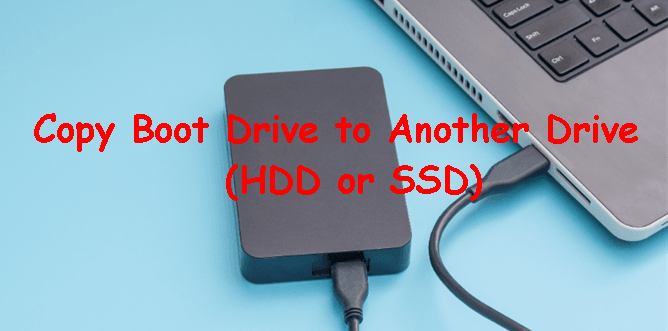This article describes everything related to copying boot drive to another in Windows 7, 8, 10, and 11 without reinstalling. AOMEI Backupper Professional, a powerful cloning software, can help a lot.
How to move boot drive to another drive? The easiest way is to use disk cloning software, which transfers the OS, drivers, programs, and data to ensure a bootable system. Since Windows lacks built-in cloning tools and reinstalling is time-consuming, we recommend professional cloning software for a seamless process.


We strongly recommend you use powerful cloning software - AOMEI Backupper Professional.
HDDs offer large capacities (e.g., Seagate BarraCuda, WD Blue, up to 8TB), while SSDs deliver better performance (e.g., Samsung 990 Pro, Crucial T705, WD Black SN850X).
Choose the right form factor (2.5-inch, M.2) and connector (SATA, PCIe, NVMe). Ensure the new drive is 2–3 times larger than the old one to avoid space or boot issues.
If you want to copy boot drive to a smaller SSD, you need to be sure the used space on the old disk and free up more space if it's larger than smaller SSD. You can choose to delete some useless files and uninstall programs you no longer use. Backing up files to external hard drive before cloning it is a good way to protect your data safely.
If your computer has two slots, simply insert the new drive and secure it. If it only has one slot, connect the new HDD or SSD using an adapter or a disk enclosure via USB. For a brand-new drive, initialize it first to make it visible in File Explorer (refer to how to initialize new disk if necessary).
Some manufacturers offer migration software to help smooth out the process, such as Samsung Data Migration, WD edition of Acronis True Image, etc., to migrate their data from one hard drive to another.
But there are some restrictions while using it. If you experience any unpleasantness, try third-party hard drive and SSD cloning software - AOMEI Backupper. It works for all Windows operating systems and any disk brands.

Now learn how to copy Windows boot drive to another drive using AOMEI Backupper below:
Step 1. Install AOMEI Backupper Professional
Click the download button to get an .exe file and double-click it for installation. Then, follow the on-screen instructions to complete this process and open it.
Step 2. Choose the Disk Clone feature
On the main page of AOMEI Backupper, click Clone and Disk Clone to start the cloning process.
If your smaller SSD cannot hold all data on the old disk after freeing up space, try the "System Clone" feature to only move boot partition in Windows 10 or 11.
Step 3. Choose the Source Disk and Destination Disk
The source disk is the old drive containing the operating system (to be cloned), while the destination disk is where the cloned data is to be kept.
Note the data on the destination disk will be overwritten or deleted. Please backup files in advance. Click OK to continue if you've done this.
Step 4. Manage Your Disk and Start Clone
Click SSD Alignment to accelerate the reading and writing speed of SSDs. Confirm the operation and click Start Clone to clone boot drive in Windows 10.
Optionally, click the "Edit Partitions" feature and select "Add unused space to all partitions" or "Manually adjust partition size" to show the full capacity of a cloned disk.
You can also enjoy the Convert the destination disk from MBR to GPT option, or vice versa, depending on the disk partition styles between them. So you don't need to convert partition style before or after cloning.
Sometimes, your computer will not boot from the target drive automatically, especially for a laptop. For a desktop, you can directly change boot order to set the boot priority for cloned disk, then it will boot.
But if you are using a laptop, you need to take out the old hard drive and install SSD on the location of your original hard drive. If you don’t switch the boot drive in Windows 11/10/8/7, it may boot from the original hard drive automatically. Then, set the cloned hard drive to the first boot option and boot from it.
If your target disk has a different partition style than the source disk, and its GPT, please change Legacy BIOS to UEFI, and vice versa.
Don’t format the older boot disk until your computer can boot from the new drive.
If your HDD is still working well, you can use SSD for OS and HDD for storage. Therefore, you can enjoy the high performance of SSD and big capacity of HDD.
The answer is yes if you can copy everything on the boot drive including the system partition, which is necessary for Windows to start. The easiest method is to use a powerful hard drive and SSD cloning software, such as AOMEI Backupper Professional.
Copying a boot drive to a new drive is a common practice in computer maintenance and upgrades. There are several reasons why this should be done:
Speaking of moving boot partition to another disk, you need to include OS-related partitions, such as C drive, system reserved partition, or EFI system partition, etc., instead of the entire disk. Then, how to copy them? It would help if you had professional disk cloning software.
You need to employ a simple and easy-to-follow SSD cloning software, such as AOMEI Backupper Professional, and clone C drive to new SSD following the outlined guide.
It depends, and there are some factors to consider. It decides whether your boot drive works properly on another computer.